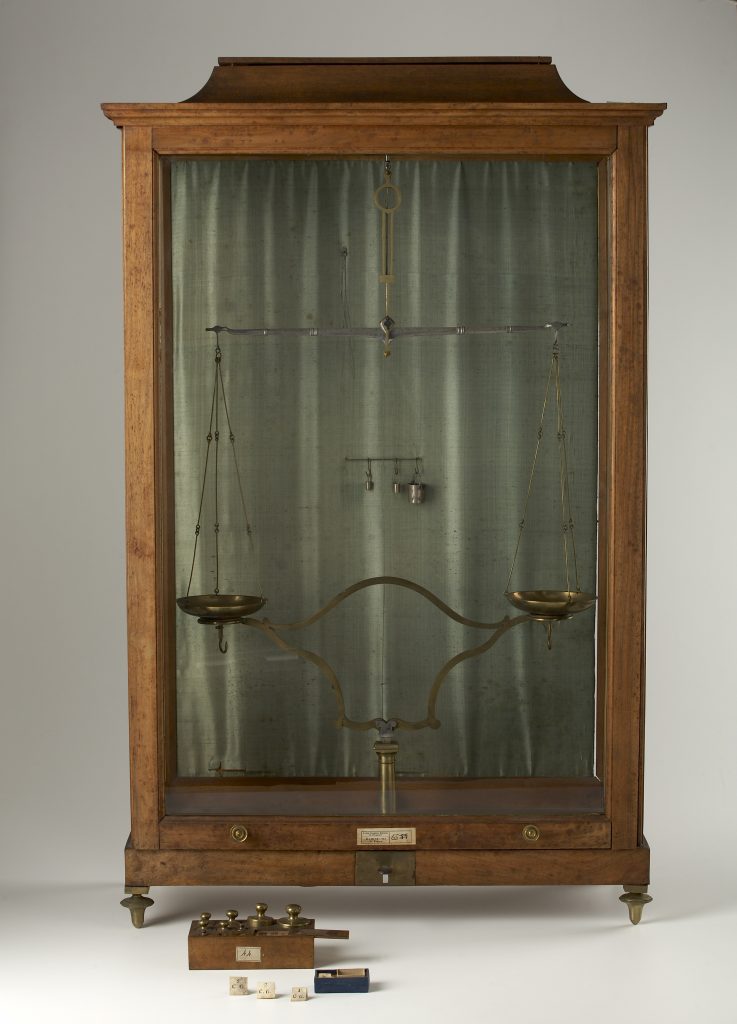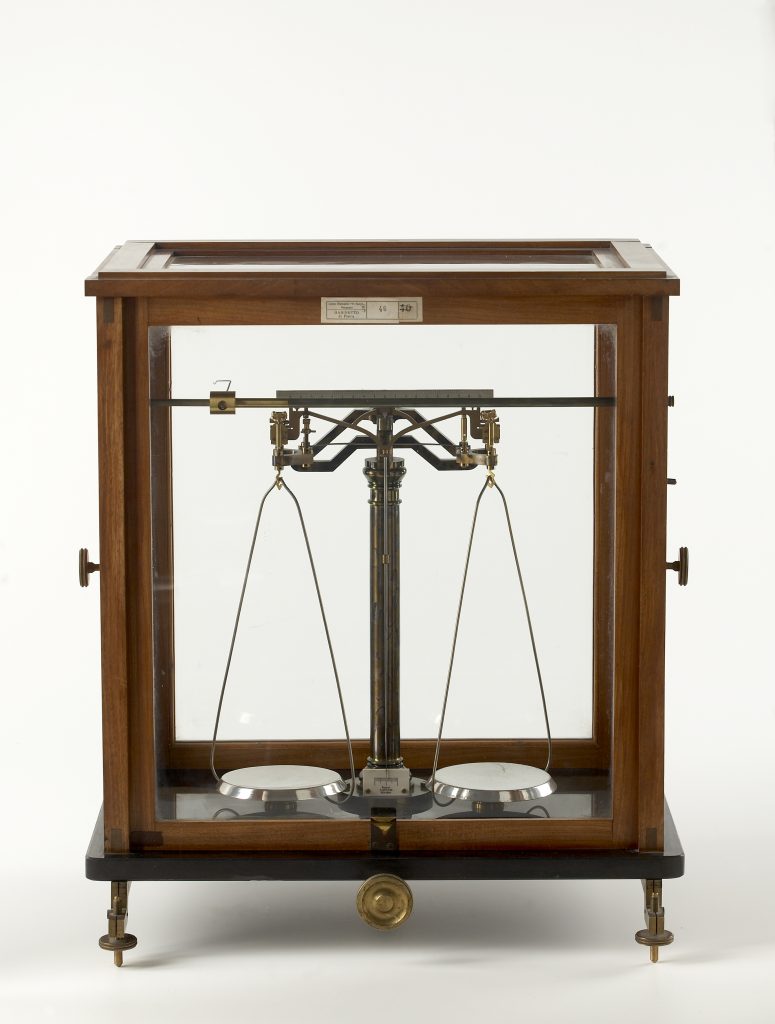01-L BILANCIA – BALANCE

Ottone, argento, vetro, legno
teca: 600 x 250, h. 950
Giò Cattinetti a Milano
1/4 XIX secolo
Bilancia a due piatti in un’elegante teca di legno di noce e vetro; lo sportello scorre verso l’alto per consentire l’accesso alla bilancia. Al giogo, sospeso al soffitto della teca, sono sospesi mediante fili metallici i piatti in ottone dotati di ganci per le esperienze di idrostatica. I piatti si appoggiano nella posizione di riposo a un sostegno in ottone che può essere alzato mediante la leva posta sul lato anteriore della teca.
La bilancia è dotata di un secchiello d’argento e di un altro completo, per l’esperienza di Archimede, nonché di un astuccio in legno contenente i pesi.
Data di acquisto 1809 – 10.
Nell’astuccio sono contenuti i pesi della libbra milanese (1 libbra, 6 – 3 – 2 – 1 once, 12 – 6 – 3 denari) e i grani (12 – 6 – 3) e frazioni, cui vanno aggiunti otto pesi delle frazioni di grano avvolti in cartine. Sull’astuccio è stata applicata un’etichetta in carta sulla quale si legge: “campioni della libbra sino ad 1/32 del grano del peso di Milano”. La corrispondenza approssimata dei pesi milanesi con i grammi è la seguente: 1 libbra = 12 once = 326,8 g; 1 oncia = 24 denari = 27,2 g; 1 denaro = 24 grani = 1,1 g; 1 grano = 0,047 g.
Riferimenti: LPSAS, LXIII, Nota 30 marzo 1811.
Brass, silver, glass, wood
case: 600×250, h. 950
Giò Cattinetti, Milan
¼ XIX century
Twin-pan balance in an elegant display case made of nut wood and glass, mounted on adjustable metallic feet; the lid slides upwards to allow access to the balance. A bracket hanging from the ceiling of the case supports the balance beam, which has a vertical indicator to verify the balance, with a metallic wedge. The brass pans, equipped with hooks for hydrostatic experiments, hang from the balance beam via metallic wires. A brass column is attached to the bottom of the case, and it holds up an elegant brace, also made of brass, which can be moved to hold the pans when at rest. The raising lever is located in the front of the case, but it is currently unusable. The balance has a silver bucket and another kit for experiments related to Archimedes’ principle, and a wooden case with two slots: the first contains weights of the Milanese pound (1 pound, 6-3-2-1 ounces, 12-6-3 denari [1 denaro is 1/24th of a Milanese ounce]), the second contains grani [1 grano is 1/24th of a denaro] (12-6-3) and fractions, plus eight weights of fractions of grani wrapped in paper. On the case, there’s a paper tag that reads: “samples of the pound to the 1/32nd of the Milanese grano.” The estimated equivalent weight in grams is as follows: 1 pound=24 ounces=326.8 g; 1 ounce=24 denari=27.2 g, 1 denaro=24 grani=1.1 g, 1 grano=0.047 g.
The manufacturer’s signature is engraved on the wedge and on the brace.
Date of purchase: 1809-10
04-L BILANCIA DI PRECISIONE DELLA PORTATA DI 500 GRAMMI – 500 GRAM WEIGHT CAPACITY PRECISION BALANCE

Metallo, ottone, legno, vetro
teca: 490 x 350; h. 570
Sartorius F. – Göttingen
4/4 XIX secolo
Bilancia di precisione a giogo corto inserita in una teca in legno e vetro apribile; una manopola posta anteriormente alla base della custodia mantiene sollevato il giogo quando non è in posizione di lavoro e lo abbassa appoggiandolo su un cuneo di agata.
Al centro del giogo è collegato l’indice, la cui estremità sfiora una scala posta alla base della colonna portante. La scala reca in basso la firma del costruttore. I piatti della bilancia sono sorretti da fili metallici, i quali appoggiano, mediante ganci, su cunei pure in metallo. Al di sopra del giogo è posta un’asta orizzontale che reca incisa una scala 9 – 0 – 9, con divisioni 1: 1; su quest’asta potevano essere appoggiati i cavalieri (mancanti) sfruttando il movimento di un’astina ricurva comandata da una manopola alloggiata sul lato destro della teca.
Sono annessi un astuccio in legno contenente pesi in ottone da 200 g a 1 g e una pinzetta con le punte in avorio, ed una astuccio in legno contenente le frazioni del grammo in platino.
Data di acquisto 1893.
Metal, brass, wood, glass
case: 490 × 350, h. 570
Sartorius F. – Göttingen
4/4 XIX centuryPrecision balance with short yoke inserted in a wooden and glass case that can be opened and mounted on adjustable brass feet. A vertical metal column that holds the yoke rises from the base; a mechanism, controlled by a knob placed in front of the base of the case, keeps the yoke raised when it is not in the working position and he lowers it by placing it on an agate wedge.The index finger is connected to the center of the yoke, its end touches a scale at the base of the column carrier. The scale bears the manufacturer’s signature. The scales are supported by metal wires, which rest on wedges also in metal via hooks. Above the yoke there’s a horizontal shaft engraved with a 9 – 0 -9 scale, with 1: 1 divisions; on this beam weights (missing) could be supported by using the movement of a curved rod controlled by a knob housed on the right side of the case. A wooden case containing brass weights between 200 and 1 g, a wooden case containing the fractions of the gram in platinum and pincers with ivory tips.
Date of purchase: 1893